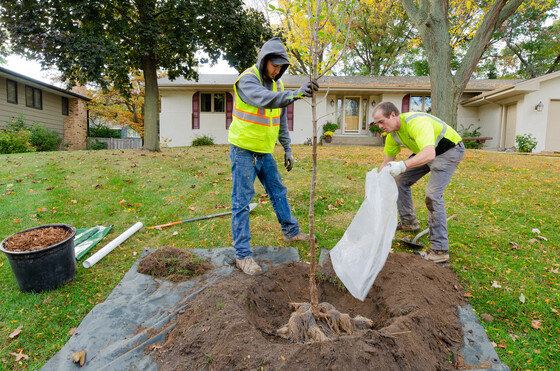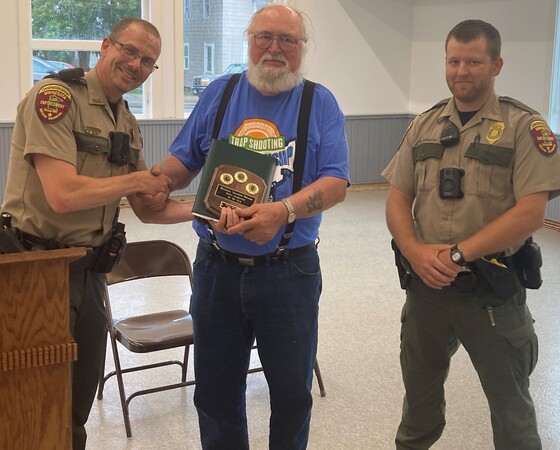In This Issue
On July 14, the Minnesota Department of Natural Resources is launching the Junior Ranger program, which offers a new activity booklet for kids at Minnesota state parks. Kids can pick up a free Junior Ranger booklet, available during open office hours at state parks, to begin the adventure.
In the Junior Ranger program, kids will investigate the ways that plant and animal adaptations are like superpowers through a mix of on-the-page and on-the-trail activities. They might discover state park habitats, move like an animal, focus on their senses, learn how to protect wildlife, avoid poison ivy, outsmart ticks and more. When kids complete the activities, they earn a free Junior Ranger patch, which they can obtain at a state park ranger station or visitor center.
The booklet activities were created by state park naturalists to encourage learning and exploration for ages 6-10, or anyone young at heart. Get more details on the program, including where to find the booklets and patches, by visiting the Minnesota DNR?s Junior Ranger webpage (mndnr.gov/junior-ranger).
The Junior Ranger program is funded through the Clean Water, Land and Legacy Amendment. Legacy funds support Minnesota DNR programs and projects that go beyond the results achieved by other state funds, to build a long-term conservation legacy for Minnesotans.
 Photo credit: Minnesota DNR
Thirty-five Minnesota communities received a collective $2.4 million boost in their ability to protect urban forests thanks to funding provided by the Minnesota Environment and Natural Resources Trust Fund as recommended by the Legislative-Citizen Commission on Minnesota Resources. The grant program began in 2022 and runs through June of 2025.
Communities will use the funding from the Protect Community Forests by Managing Ash for EAB Grants Program for tree inventories, management plans, ash tree removal, treatment with non-neonicotinoid insecticides, tree planting, and materials to support newly planted trees, such as staking, water bags, and mulch.
?Minnesota?s cities and towns contain a significant number of ash trees, which are now at risk of attack by the emerald ash borer, a non-native insect,? said Emma Schultz, Minnesota DNR Community Forestry grant specialist. ?This destructive beetle can kill ash trees in just a few years, and all ash trees in the state are at risk of infestation.?
Identifying infected or at-risk trees and addressing EAB-related challenges is an obstacle for many communities. The grants will help recipient communities take preemptive measures that are more cost effective than waiting for ash trees to become infested.
For example, the city of Aitkin will use its grant award to better manage the community trees that improve the quality of life of residents and contribute to the natural setting that draws visitors to the area, both of which are important for the local economy.
?The city of Aitkin is now starting to understand its community forest and the resources necessary to properly manage them,? said Troy Holcomb, Minnesota DNR forester. ?Tax bases are smaller in greater Minnesota and city staff and budgets need to focus on meeting basic community needs like sewer service and usable streets. This grant money allows the city to perform a tree inventory and create a management plan. The city can now work smarter and target limited resources to where they are most needed. Being proactive is easier and more affordable than being reactive.?
In Rochester, where EAB was first discovered in 2015, ash comprised 15% of the estimated 100,000 public trees.
?EAB has drastically changed the way our urban forest looks,? said Alison Litchy, Urban Forestry program coordinator in Rochester. ?Fortunately, we are able to treat and maintain treatments for approximately 4,000 public ash trees through the help of this grant. Preserving these trees through treatment allows us to retain the canopy of 8% of our public tree population. The retained trees provide a variety of benefits to our community such as reducing temperatures, capturing air pollutants, and slowing down stormwater during this great time of loss. We use non-neonicotinoid insecticides and knowledgeable certified arborists to treat trees to protect pollinators and other non-target organisms.?
To date, EAB has been confirmed in 41 of Minnesota?s 87 counties. For a list of these counties, visit the Minnesota Department of Agriculture?s?interactive?map (tinyurl.com/mnag-eab-map).
The next round of grant funding is anticipated to open by August 2023, with more than $16 million available. Interested applicants should visit the Minnesota DNR?s Community Forestry webpage?(mndnr.gov/forestry/urban) or contact the Minnesota DNR Community Forestry Grants Team at?[email protected].
Protect Community Forests by Managing Ash for EAB Grants
- Aitkin: $57,860
- Apple Valley: $136,400
- Bemidji: $11,824
- Brooklyn Center: $60,450
- Buffalo: $64,160
- Columbia Heights: $63,450
- Duluth: $99,081
- Eden Prairie: $116,987
- Hayfield: $40,000
- Heron Lake: $36,981
- Hopkins: $123,200
- International Falls: $62,000
- Lakeville: $54,830
- Lamberton: $40,000
- Mankato: $56,324
- Moorhead: $110,000
- Mound: $70,775
- New Prague: $60,800
- Newport: $67,117
- Oronoco: $9,456
- Otsego: $25,000
- Ranier: $25,000
- Robbinsdale: $32,500
- Rochester: $149,546
- Saint Anthony Village: $20,000
- Saint Louis Park: $25,321
- Saint Peter: $128,480
- South St. Paul: $123,000
- Warren: $19,000
- Waseca: $78,079
- West Concord: $60,023
- White Bear Township: $57,981
- Winona: $124,775
- Woodbury: $149,600
- Wyoming: $40,000
Contact the local community forestry program or the Minnesota DNR Community Forestry Grants Team at?[email protected] for more details on individual grant recipients.
###
 Photo credit: Minnesota DNR
The Minnesota Department of Natural Resources has named Donald Belange, a Hoyt Lakes resident, as the 2022 volunteer firearms safety instructor of the year.
Belange has been a volunteer instructor for 23 years. In that time, he?s taught two to four classes a year and had a role in certifying more than 500 students. He?s a veteran, firearm enthusiast and gunsmith who was instrumental in bringing Archery in the Schools and clay target shooting (he still helps coach the local high school clay target team) to the community. Likewise, he played a key role in the creation of the East Range Sportsman?s and Conservation Club in Aurora, where firearms safety field days are now held.
Belange considers firearms safety certification an important milestone in youth?s lives and cherishes the role he and other volunteer instructors play.
?There?s nothing like having a 14- or 15-year-old who I taught come up to me and show me a picture of the deer they shot, or tell me about the best hunt they ever had,? Belange said. ?I had one kid come back who wasn?t hunting but got lost in the woods and they used what they learned in class to get themselves out of that situation. It?s common to reconnect with kids you taught because you?re one of the people in their life they never forget.?
Over the years, Belange has emphasized the recruitment of new volunteer instructors to ensure anyone who wants to take firearms safety can do so. While he?s modest about his accomplishments and credits those with whom he works, Belange is a deserving recipient, according to Capt. Jon Paurus, DNR Enforcement education program coordinator.
?Don has played and continues to play a vital role in creating a legacy of safe hunters and outdoor enthusiasts,? he said. ?He represents the best of our volunteer instructors, which is saying a lot since there are so many good ones, and the students who learned from him no doubt are better for it.?
More than 4,000 volunteer instructors teach Minnesota DNR firearms safety courses across the state. Since the firearms safety program began in 1955, more than 1.3 million students have been certified. DNR firearms safety certification is required of anyone born after Dec. 31, 1979 to buy a hunting license in Minnesota. Youth age 11 and older can attend a firearms safety certification course and receive their certificate, which becomes valid at age 12.
For more information on the dates and locations of available safety courses, and to sign up for alerts when new classes are added, visit the firearms safety webpage of the Minnesota DNR website (mndnr.gov/safety/firearms).
###
Hunters can apply for the regular archery deer hunt at Camp Ripley near Little Falls. The application deadline is Friday, Aug. 18.
This year, the three-day hunt will occur on Oct. 27-29 (Friday through Sunday, application code 668). A total of 2,500 permits will be made available. Successful applicants must buy a valid archery license to participate. The bag limit for this year?s hunt is two, and bonus permits may be used to take antlerless deer.
Hunters can find how to apply, the cost to apply, identification and age requirements, how to apply as a group, and important hunt rules and instructions, on the Minnesota?DNR website?(mndnr.gov/hunting/deer/camp-ripley-archery-hunt.html).
The archery hunt at Camp Ripley is an annual event. The Minnesota Department of Natural Resources coordinates the hunt in collaboration with Central Lakes College Natural Resources Department, and the Department of Military Affairs, which manages the 53,000-acre military reservation.
###
|
